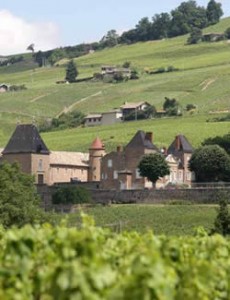Georges Dubouef Chateau des Capitans 2011 Juliénas, France, $19.00 Beaujolais bashers need not apply. We typically think of Beaujolais in the fall when Beaujolais Nouveau est arrivé – the third Thursday of November. But, Beaujolais is much more than Nouveau and, as a lighter-bodied red, it’s perfect for summer sipping. Produced from the thin skinned Gamay grape, Beaujolais is generally low in tannins, high in acidity, with bright cherry fruit and capable of taking a slight chill.
Nouveau aside, the Beaujolais hierarchy starts at the base with Beaujolais, while wines produced with grapes sourced from the better vineyards (located in 39 well regarded villages) are a step above and labeled as Beaujolais-Villages. Even more rarified as those wines designated as crus, which are named and labeled for one of the ten villages their grapes respectively come from.
Belying its Roman origin having been named for Julius Cesar, Juliénas is located quite northerly in the Beaujolais region where the more granitic soils are found. Situated within the heart of Juliénas, the Chateau des Capitans estate is home to a 19th century castle. Since the site is thought to have been a headquarters for military staff during the Gallo-Roman period, the castle’s name pays homage to the captains who presumably lived there once upon a time.
Tasting note: Aromas of fresh cherries, cinnamon and wet leaves persist on the palate with high acidity, light body and low tannins; nice round mouthfeel and good length.
Georges Duboeuf Domaine les Chenevières 2011, Mâcon-Villages, France, $14.00 Just north of Beaujolais, the Mâconnais district is part of the Burgundy region and is known for its Chardonnay. The district is structured similarly to Beaujolais in that wines feature either the basic appellation of Mâcon, the higher appellation of Mâcon-Villages or the more prized appellations of Pouilly-Fuissé, Pouilly-Loché, Pouilly-Vinzelles, Saint-Véran and Viré-Clessé. However, the district also permits village level wines to append the name of specific villages or communes, as in the case of Mâcon-Lugny.
With a warmer climate than that found in the Cote d’Or district, Mâconnais Chardonnays generally offer up riper and more tropical fruit notes as well as lower price points. Domaine les Chenevières has been the setting for five generations of winemaking for the family that owns it, with portions of the family’s residence built over 300 years ago.
Tasting note: On the nose, this wine displays damp earth, butter and apple notes. The dry palate offers bright acidity, medium-full body and an elegant richness; unwooded with 100% malolactic fermentation.

